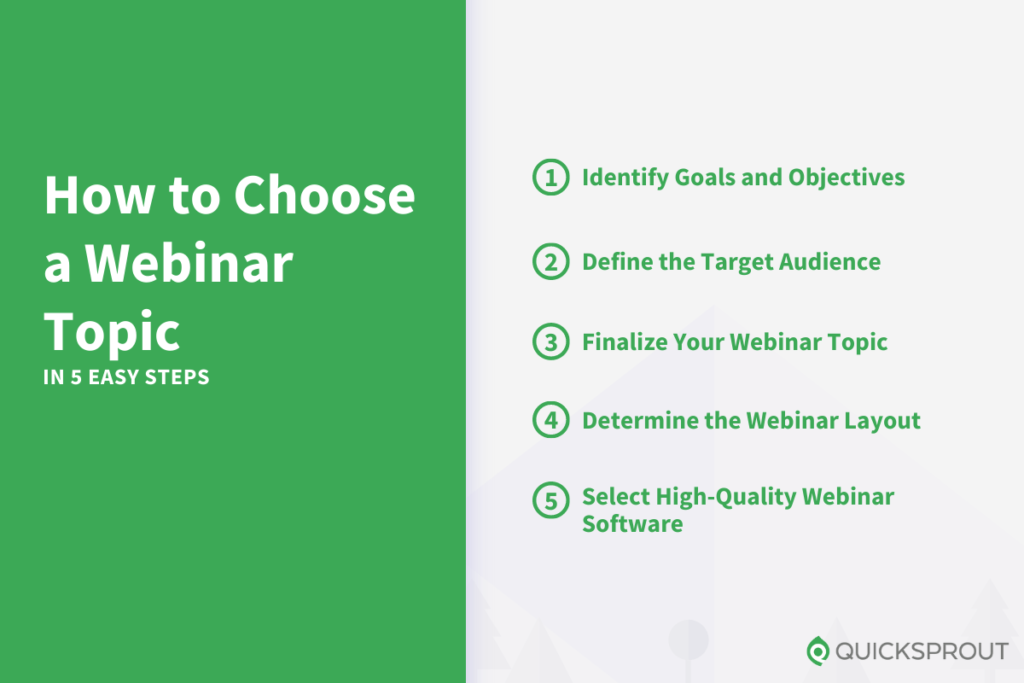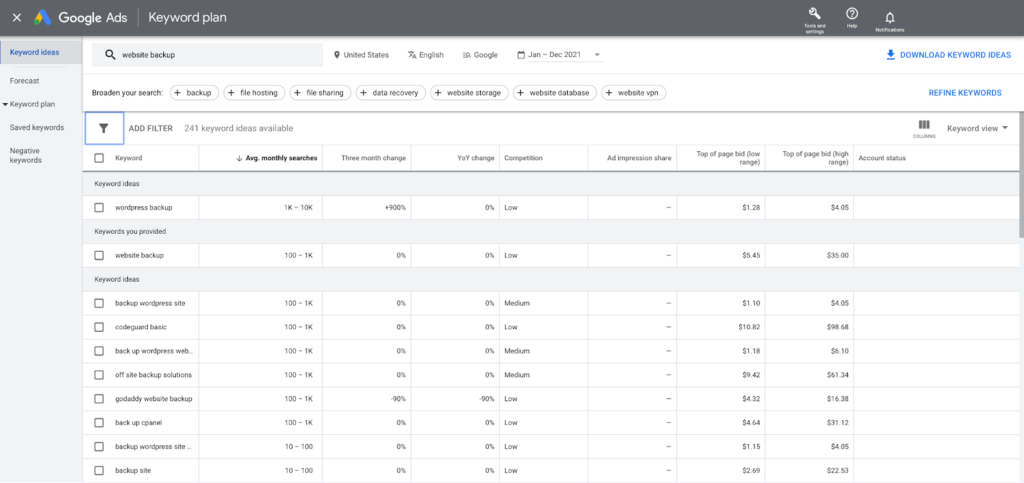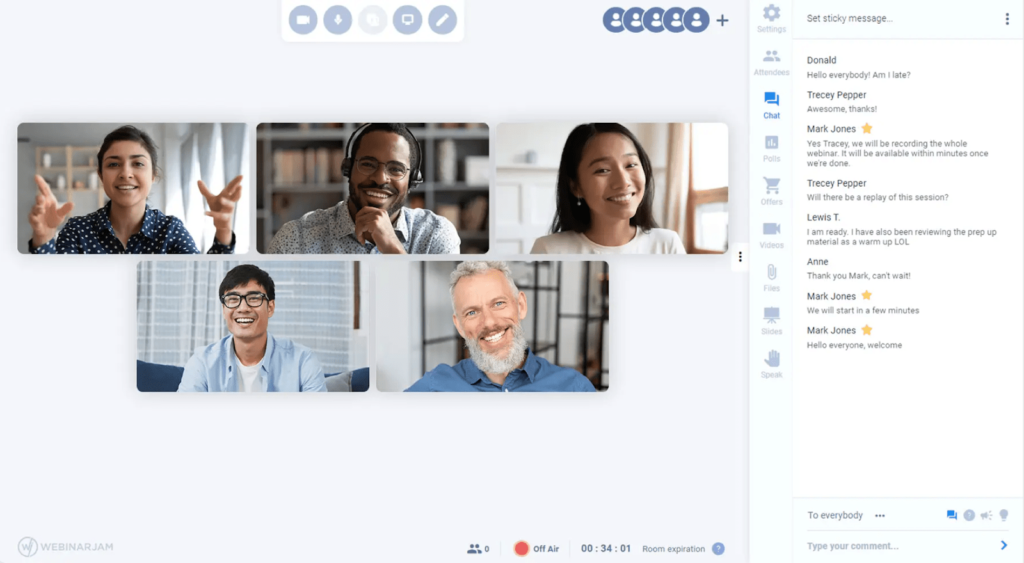Webinar success is often measured by registration and attendance. But in today’s non-stop, tech-driven world, how do you rise above the noise and capture the attention of busy prospects? And once you do, how do you get them to actually commit their time to show up for your webinar?
The secret is to offer a topic that is interesting, engaging, and, above all, valuable. If you don’t, you may find yourself presenting to empty seats. To ensure your webinar is standing room only–virtually anyway–it’s critical to choose a great webinar topic. In this article, I’ll show you how easy that is to do.
How to Choose a Webinar Topic in 5 Steps
Selecting the right webinar topic involves more than just picking a subject that is interesting to you. It requires a strategic approach and analysis. But that process isn’t as hard as it sounds. You can choose a winning webinar topic and create a successful webinar in just five steps:
- Identify Goals and Objectives
- Define the Target Audience
- Finalize Your Webinar Topic
- Determine the Webinar Layout
- Select High-Quality Webinar Software
Ready for success? I’ll walk you through the full webinar planning process in detail.

#1. Identify Goals and Objectives
Choosing a great webinar topic begins with a little legwork. Start by thinking about why you want to do a webinar in the first place. What do you hope to accomplish?
Here are a few common reasons people put on webinars.
Reach and Teach Employees
With more and more workforces going remote, sharing important information with employees–and ensuring they understand it–can be a daunting task. Zoom is a great option for smaller meetings among teams or departments. But when you need to reach larger groups or even an entire large organization, a webinar is far more efficient. It allows the host and presenters to control the exchange of information and avoid the typical interruptions that arise when anyone on a call can freely access their microphone.
Onboarding and employee training are other areas where webinars can be quite valuable. Creating a webinar that covers all the basics of starting the new job or learning common performance skills and processes eliminates the need for HR or other managers to repeat the same information again and again for every new hire.
Support Sales & Marketing Teams
When done well, webinars can be an effective component of your company’s overall marketing and sales strategy. Product-specific webinars can attract leads and get prospects in the sales funnel. Webinars can also provide valuable information that can be saved and easily shared with decision-makers when a prospect is considering your company’s products or services.
The sales funnel itself is ripe with webinar opportunities, too. Find out where prospects tend to hit roadblocks, then build your webinar to ease those pain points. Whether it’s a lack of clarity on a product’s functionality or a missing value proposition, a webinar is a great way to have that information available to leads on demand. It can help move them through the funnel instead of being stymied by indecision and dropping out altogether.
Help Customers After the Sale
After the sale is an equally valuable place for webinars. When you know the common problems your customers consistently ask about, for example, you can design a webinar to solve them. Put the recording on your website and customers may even be able to solve their issue without ever contacting customer service at all.
You can also design webinars that showcase unique features of your products that customers might not know about. This value-added approach is a great way to increase customer satisfaction, encourage referrals, and even turn a one-off customer into a strong referral source or even a repeat buyer.
#2. Define the Target Audience
Now that you know the “why” about your webinar, it’s time to focus on the “who and what” part of the equation. Resist the urge to build a webinar that tries to be all things to all people. That strategy rarely succeeds. Webinars are way more successful when they offer a precise topic aimed at a narrow, well-defined audience.
Here’s how to answer the “who” and “what” part of choosing a webinar topic.
What does your ideal attendee look like?
I’m not talking about actual appearance here. I mean the intangible characteristics of your ideal webinar attendee.
For example, an onboarding webinar that walks someone through setting up benefits and payroll is geared towards new hires. A “how to” webinar explaining the nuts and bolts of registering a product warranty is geared toward customers who have already purchased your product.
But when your audience isn’t so readily defined, it helps to think about audience characteristics when defining your ideal attendee. Start by talking to your sales and marketing teams. They can be a big help in defining your company’s ideal customer, and likely have audience personas created already. Reviewing this information can help you quickly hone in on what your ideal attendee looks like.
What does your ideal attendee need?
What is keeping your ideal attendee up at night? What issues are they having trouble solving on their own? Figuring out the problems they face or the fears they have will reveal a bevy of possible webinar topics your ideal attendee finds hard to resist.
Perhaps your company sells a product that is great at solving a complex issue but is also expensive. Your ideal attendee is someone who already knows about your product and likes it, but also has a major pain point when explaining to their boss why the high price is justified.
If you offer a webinar that clarifies all the ways your product saves time and money and enhances a company’s bottom line, you’ve helped solve that pain point. Your ideal attendee can take the webinar information back to their boss, move everyone past the price hurdle, and become a satisfied customer.
#3. Finalize Your Webinar Topic
Finally, the moment you’ve been waiting for! You’ve done your homework, figured out the “whos” and “whys” and created a webinar topic short-list. You’re ready to pick the best one.
Before you choose your final idea, though, it pays to do just a little bit more research.
Reach Out To Colleagues (again)
Yes, you already spoke to your colleagues to get some initial webinar ideas. And your short list is the product of those conversations. But it never hurts to have a deeper discussion with these same stakeholders one more time to flesh out how each idea on your shortlist might come to life.
If you are going to train employees, go back to HR and identify the most critical elements to cover for each of your short-list topics. They may come up with ideas you never thought of, or explain why one of your short-list topics should be tabled for the moment in favor of a more time-sensitive option.
Is your goal to help sales and marketing bring in more leads or convert prospects? Share your pared down topic list, explain the content you envision for each, and get their feedback on the approach they think will work best given current market conditions.
Your internal subject matter experts can be an invaluable resource for finalizing a webinar topic, and contributing to an outline that will eventually shape your final presentation.
Look At The Data
Google Ads Keyword Planner is a free tool that can help you identify keywords and topics that are hot right now. If you’re not familiar with this tool, check out our tutorial on how to use the Google keyword planner tool.

The goal of Google’s Keyword Planner is to identify phrases that people are searching for right now, and determine which of them are most popular based on search volume.
This type of information can help you in two ways. It will show you what is–and isn’t–being regularly searched for, helping you rid your webinar short-list of topics nobody cares enough about to bother with a Google search.
And when you do narrow your topics down to that final winner, the data will also show you how to name and describe your webinar topic so that it is more likely to be found during a Google Search.
#4. Determine the Webinar Layout
Okay, you landed on this post because you wanted to know how to choose a webinar topic, and I showed you how to do that. But picking a topic is just the tip of the iceberg.
There’s a lot going on under the waterline that makes or breaks an online learning experience. Consider these two final steps a bonus to help you achieve webinar greatness.
First things first, you have to decide how long your webinar will be. The most successful webinars are at or just under 60 minutes, with 30-45 minutes dedicated to the presentation and 15 minutes allocated for audience Q&A.
Likewise, you’ll have to make a decision about what materials to show during the webinar. A Powerpoint presentation is a go-to favorite, but you can also share PDFs, spreadsheets, JPEGs, and other multimedia to keep your audience engaged.
The benefit of including visuals is that it allows attendees to see the information in a different form than just a verbal presentation. This helps address a variety of learning styles, very important when you have a lot of attendees in the audience.
You’ll also need to determine who will be presenting in the webinar. Some webinars can be run by a single expert who can speak to all aspects of the webinar topic.
However, offering a moderator and two to three different presenters is also a great way to keep things fresh and maintain audience attention. This is an especially great strategy if your topic has diverse components, where different people are experts in each area.
#5. Select High-Quality Webinar Software
Putting on your first webinar might seem overwhelming at first. The great news is there are many webinar software options available to make the job easier. You definitely don’t have to go it alone. Webinar software does the hard technical work for you, freeing you up to focus on the creative side of the equation.

If you’re not sure where to start, check out our review of the best webinar software options. All of these tools will walk you through the process of setting up and hosting a webinar. And if you have other questions about actually hosting your webinar, be sure to check out our straightforward how-to host a webinar guide.
Final Thoughts About Choosing a Webinar Topic
Picking a topic for your webinar is not always an easy task. To achieve maximum success, it takes a thoughtful assessment of your goals and objectives and an analysis of your target audience.
But once you’ve done your research, zeroing in on a great topic gets a lot easier. And when you’re ready to rock and roll, using webinar software will make planning and hosting your event easy and fun.
from Quick Sprout https://ift.tt/5vS86lI
via IFTTT
No comments:
Post a Comment